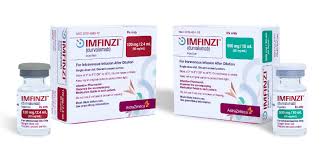
AstraZeneca isn’t giving up on its aspirations for Imfinzi in first-line non-small cell lung cancer (NSCLC), and against all odds thinks the MYSTIC data could hold a path to approval.
MYSTIC missed the mark on progression-free survival (PFS) initially, and last month on overall survival (OS) for Imfinzi (durvalumab) both as a monotherapy and in combination with AZ’s experimental CTLA4 inhibitor tremelimumab.
Most observers interpreted that as complete failure for the programme in first-line NSCLC, a category dominated by Merck’s Co’s rival checkpoint inhibitor Keytruda (pembrolizumab).
Now, AZ is pointing to a trend towards in improvement with Imfinzi on its own for OS, which it says was reduced by 24% at the primary data readout and seems more pronounced after two years’ follow-up, at 38.3% for monotherapy versus 22.7% for standard-of-care chemotherapy.
The company has now drilled even deeper the data and found that Imfinzi’s activity seems to be strongest in patients with a high tumour mutation burden (TMB), a somewhat controversial biomarker also being used by Bristol-Myers Squibb) to make a case for its PD-1 inhibitor Opdivo (nivolumab) after it also failed in first-line NSCLC.
A high TMB reading indicates more markers on the cancer cell surface that might make them vulnerable to cancer immunotherapy, although in BMS’ study the survival rates for high- and low-TMB patients seemed similar, raising questions about whether a regulator would approve a TMB-focused indication.
“The first phase 3 data on blood TMB in this setting show an association between high TMB and overall survival benefit with immunotherapy,” according to AZ, which says it will now expand and tweak the protocol of its ongoing NEPTUNE trial of Imfinzi with tremelimumab in first-line NSCLC that is due to generate results early next year.
There will no doubt be debate about the role of tremelimumab in that study, however, given that the combination also failed the EAGLE trial in head and neck cancer earlier this month and it is hard to explain why the duo performed worse than Imfinzi on its own in MYSTIC.
The new analysis from MYSTIC was reported the ESMO Immuno-Oncology conference in Geneva this week by Naiyer Rizvi of Columbia University Medical Centre in the US, who suggested the OS results were “clinically meaningful” even though they didn’t reach statistical significance.
AZ’s study looked specifically at patients whose tumours express PD-L1 on 25% or more of their cancer cells, and AZ says it is now important to explore the relative roles of PD-L1 expression and TMB in determining the efficacy of immunotherapy.
Pragmatically, the TMB data is what holds the key for Imfinzi to find a short-cut to approval for first-line NSCLC however, and the task in hand for both AZ and BMS is to persuade regulators that the biomarker is valid.
BMS is testing the FDA’s view on this with an application for Opdivo plus its CTLA4 inhibitor Yervoy (ipilimumab) in first-line patients with TMB above 10 mutations per megabase, with a verdict due by 20 February next year.
Even if successful, doctors will still have to be persuaded to add in a TMB test for the first-line patients rather than just starting therapy straight away with Keytruda and chemotherapy.
AZ can in some respects afford to gamble a little more of its R&D budget on Imfinzi and tremelimumab as Imfinzi is making gains in another segment of the NSCLC market – as a maintenance therapy for locally-advanced NSCLC patients whose tumours cannot be removed surgically.
It’s already been approved for use in this group based on the results of the PACIFIC trial, with analysts suggesting that could add $1bn to Imfinzi’s overall sales.




